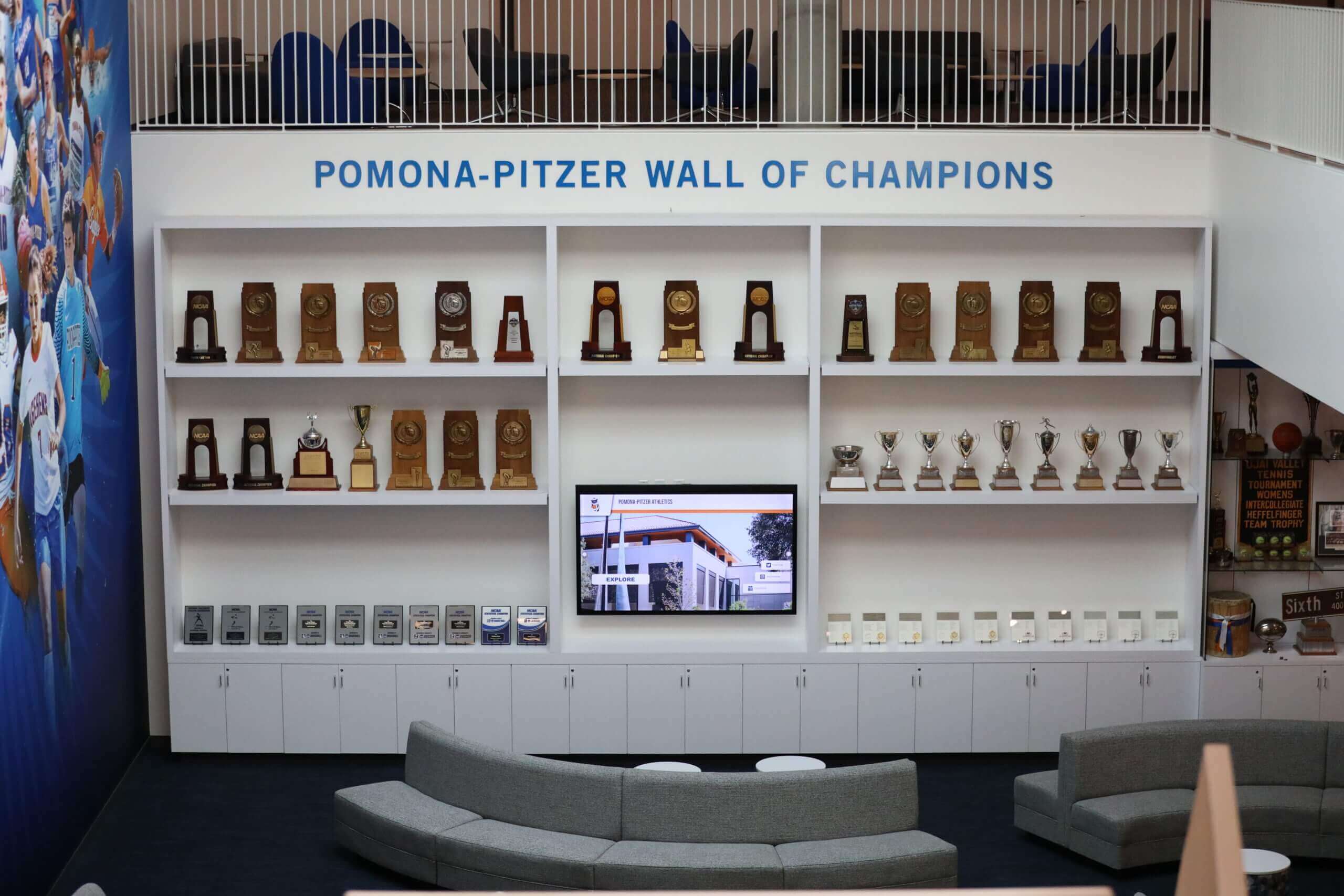Key Takeaways
Complete buyer's guide for athletic directors with tight budgets. Learn how to fund digital recognition displays through creative strategies, maximize value, and choose the right solution.
The Budget Reality for Athletic Directors
Athletic directors face an increasingly challenging financial landscape. Traditional revenue sources rarely cover the full scope of program needs, from equipment and travel to facility maintenance and, yes, athlete recognition. When budgets tighten, recognition often falls to the bottom of priority lists—viewed as a “nice-to-have” rather than essential program element.
Yet recognition directly impacts the outcomes athletic directors care about most: athlete motivation, program reputation, recruiting success, and community support. Schools that maintain robust recognition programs report higher athlete engagement, stronger parent satisfaction, increased booster support, and improved recruiting outcomes—all of which justify recognition as strategic investment rather than discretionary expense.
Understanding Recognition Costs
Traditional recognition methods carry substantial ongoing expenses:
Physical Trophy Case Limitations:
- New display cases: $2,000-$8,000 each
- Trophy engraving: $50-$200 per award
- Plaques: $75-$300 each
- Frame updates: $30-$100 per season
- Installation labor: $500-$1,500 per project
- Limited space requiring difficult choices
The Hidden Costs:
- Staff time managing physical displays
- Storage space for overflow trophies
- Maintenance and cleaning
- Repairs for damaged displays
- Updates every season requiring new materials
Digital recognition solutions transform this cost structure. While requiring upfront investment, they eliminate most ongoing expenses while dramatically expanding recognition capacity.
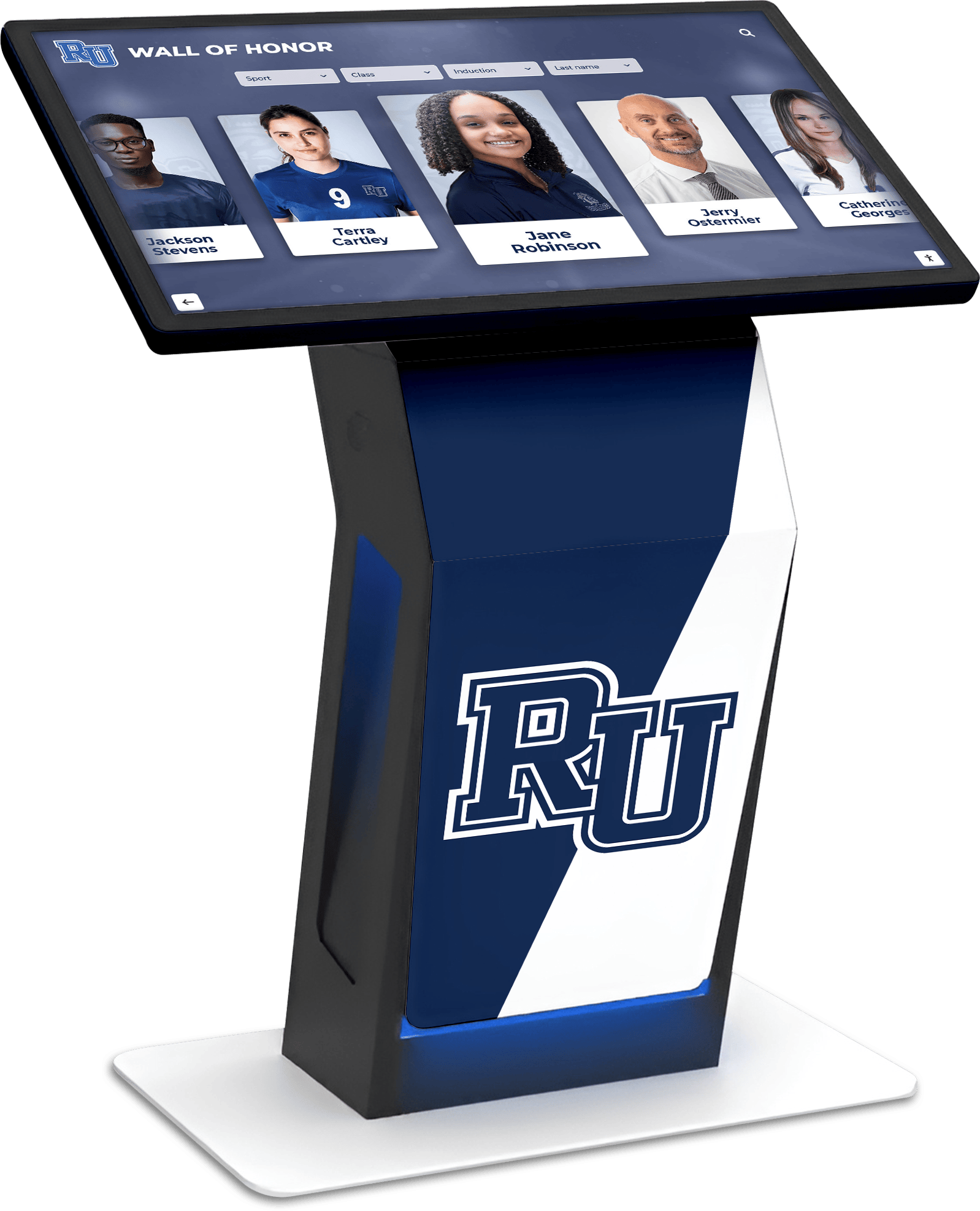
Digital Recognition Pricing: What to Expect
Understanding the digital recognition market helps athletic directors make informed decisions and budget appropriately.
Software-Only Solutions ($2,000-$5,000 annually)
The most budget-friendly approach involves purchasing software subscriptions while using existing displays or procuring hardware separately.
What’s Included:
- Cloud-based content management system
- Pre-designed templates for athletic recognition
- Regular software updates and improvements
- Technical support and training
- Web-based access for remote viewing
- Social sharing capabilities
What You Provide:
- Display hardware (TV or touchscreen)
- Computer or media player
- Network connectivity
- Mounting solution
Best For: Schools with existing displays they can repurpose, programs with technical staff who can handle setup, or athletic directors comfortable managing hardware separately.
Complete Systems ($8,000-$20,000)
Comprehensive packages bundle software, hardware, installation, and support into turnkey solutions.
Typical Packages Include:
- Commercial-grade touchscreen display (43-65 inches)
- Integrated media player
- Professional software platform
- Installation and mounting
- Initial content setup
- Training and ongoing support
- Warranty coverage (1-3 years)
Why Costs Vary:
- Screen size significantly affects pricing
- Touch capabilities add 20-30% to costs
- Custom enclosures or mounting increase expenses
- Installation complexity varies by location
- Feature sets differ between providers
Best For: Schools wanting complete solutions with minimal internal technical involvement, programs valuing professional installation, or athletic departments without IT support.
Enterprise Solutions ($20,000-$50,000+)
Large programs or multi-sport installations may require enterprise-level systems.
Additional Features:
- Multiple display locations
- Advanced analytics and reporting
- Custom development and branding
- Database integration
- Priority support
- Extended warranties
Best For: Large athletic programs, schools with multiple facilities, or institutions wanting comprehensive recognition across all sports and activities.
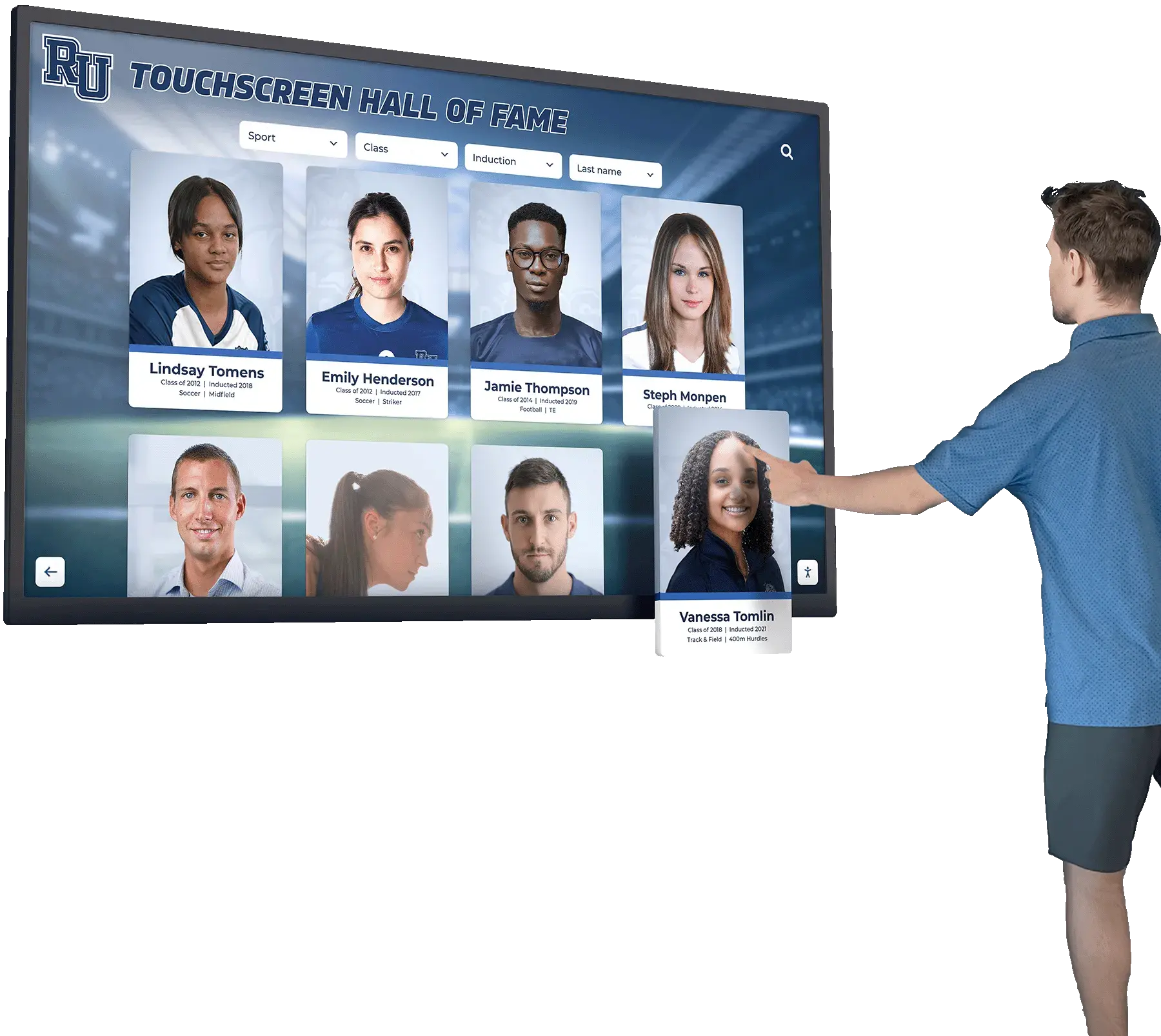
Creative Funding Strategies for Tight Budgets
The initial investment challenge stops many athletic directors from pursuing digital recognition. These proven funding approaches make projects financially feasible:
1. Booster Club Partnerships
Athletic booster clubs exist specifically to support program needs. Digital recognition perfectly aligns with their mission of celebrating athletes and building program pride.
Effective Pitch Elements:
- Show how recognition honors all athletes, not just star performers
- Demonstrate long-term value compared to ongoing trophy costs
- Explain how digital displays can feature booster sponsors
- Project lifetime recognition capacity vs. limited physical space
- Present professional mockups showing potential displays
Implementation Strategies:
- Request full funding or partner with other sources
- Propose multi-year payment plans
- Offer prominent booster recognition on displays
- Include booster logos in digital content
- Schedule unveiling at major booster events
According to schools that successfully secured booster funding, projects presented with clear ROI data and professional proposals received approval 73% of the time compared to just 28% for informal requests.
2. Use-It-Or-Lose-It Year-End Balances
Many schools face “use it or lose it” scenarios where unspent budget dollars must be allocated before fiscal year end or revert to general funds.
Strategic Approach:
- Meet with principals and finance officers in Q3
- Emphasize recognition benefits entire school, not just athletics
- Position as infrastructure investment with multi-year value
- Highlight that digital systems support academic recognition too
- Offer to share costs across multiple departments
Timing Matters:
- Begin conversations 2-3 months before fiscal year end
- Have proposals ready for quick approval
- Identify vendors who can deliver on compressed timelines
- Ensure purchasing processes accommodate timeline
Many athletic directors report securing 40-60% of project costs through year-end balances when properly positioned as school-wide infrastructure rather than athletics-only expense.
3. Alumni Fundraising Campaigns
Former athletes often feel strongly about supporting recognition for current and future student-athletes. Alumni engagement strategies create natural fundraising opportunities.
Campaign Development:
- Feature alumni prominently in digital recognition plans
- Show how system preserves historical achievements
- Offer naming opportunities for major donors
- Create giving levels with recognition benefits
- Share nostalgia-driven content activating emotional connections
Outreach Channels:
- Athletic alumni association networks
- Reunion weekend fundraising events
- Social media campaigns highlighting legacy
- Email solicitations with compelling visuals
- One-on-one meetings with accomplished alumni
Incentive Structures:
- Pioneer donors featured at launch
- Naming rights for display locations
- Permanent digital recognition of campaign supporters
- Exclusive preview events for contributors
Schools combining emotional appeals with tangible recognition benefits typically raise $5,000-$15,000 through focused alumni campaigns—often enough to fund significant portions of digital recognition projects.
4. Corporate Sponsorship Integration
Digital donor recognition displays create valuable visibility for local businesses while funding athletic program needs.
Sponsorship Packages:
- Logo placement on display home screens
- Rotating sponsor recognition in content
- Featured business spotlights
- Web presence alongside physical display
- Social media acknowledgment
Prospecting Priorities:
- Existing athletic program sponsors
- Alumni-owned businesses
- Companies targeting youth/family demographics
- Businesses near school or athletic facilities
- Organizations with community investment priorities
Pricing Strategies:
- Tiered sponsorship levels ($1,000-$10,000)
- Multi-year commitments at discounted rates
- Exclusive category sponsorships
- Package deals combining digital and physical presence
One Texas high school athletic director funded their entire $12,000 digital recognition system through local business sponsorships, with sponsors citing the modern, professional presentation as key to their participation.
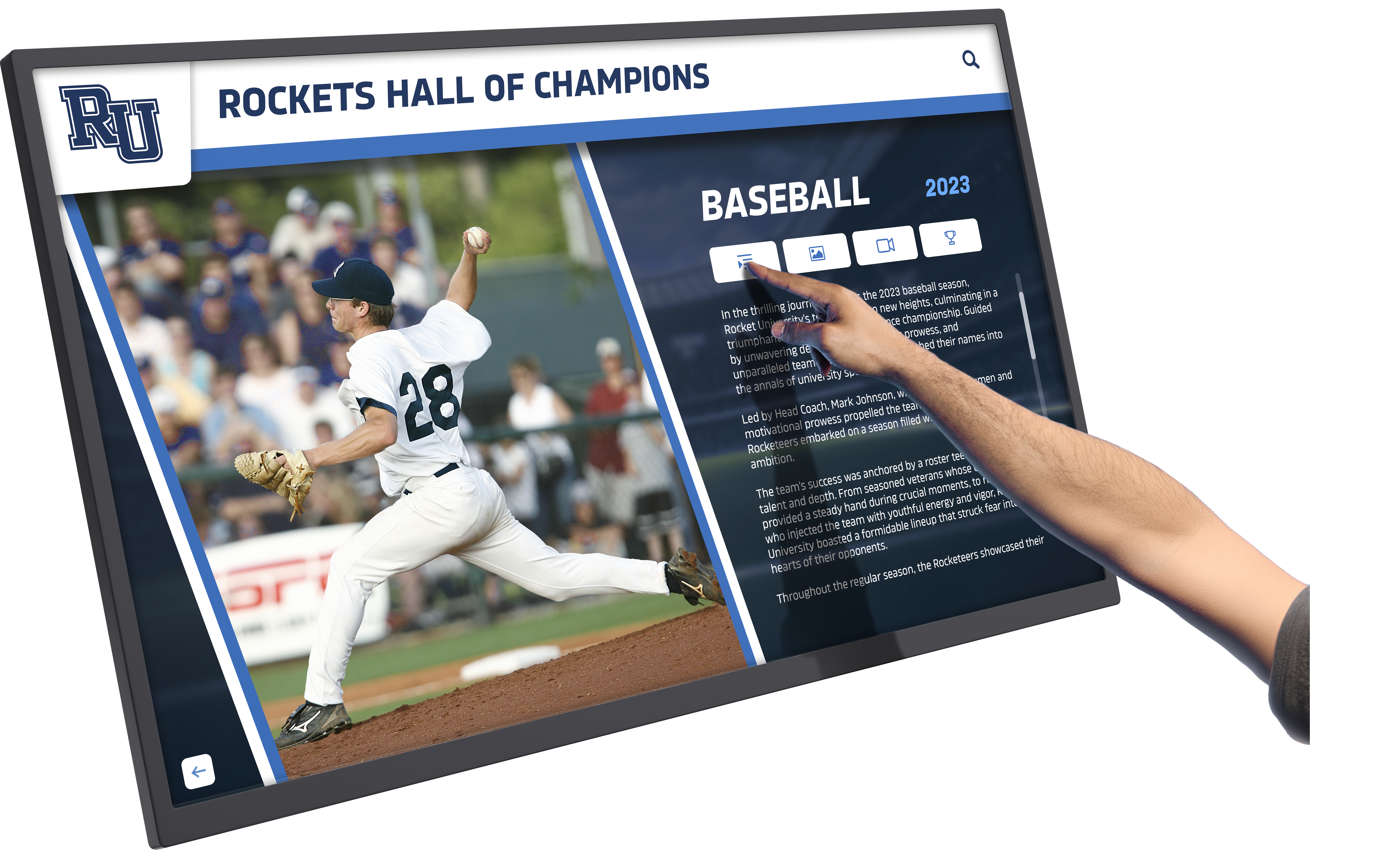
5. Grant Opportunities
While competitive, educational technology grants can fund recognition systems when positioned appropriately.
Potential Grant Sources:
- Local education foundations
- Community foundation technology grants
- State athletic association programs
- Corporate giving programs
- Regional youth development foundations
- K-12 fundraising resources
Application Strategies:
- Frame as educational technology investment
- Emphasize student engagement and motivation
- Highlight equity and inclusive recognition
- Document program improvement goals
- Include data on expected outcomes
- Partner with academic departments for broader appeal
Success Factors:
- Strong narrative connecting recognition to student success
- Clear metrics for measuring impact
- Budget justification with comparative analysis
- Letters of support from administration
- Evidence of sustainability planning
Grant success rates typically run 10-15% for educational technology projects, making this a longer-term strategy best pursued alongside other funding approaches.
6. Phased Implementation
Rather than seeking full funding immediately, many athletic directors implement digital recognition in phases spread across multiple budget cycles.
Phase 1: Core System (Year 1)
- Single display in main athletic facility
- Essential content for current sports
- Basic recognition capabilities
- Cost: $8,000-$12,000
Phase 2: Content Expansion (Year 2)
- Add historical athlete profiles
- Include additional sports
- Develop multimedia content
- Cost: $1,000-$2,000 (staff time primarily)
Phase 3: Additional Displays (Year 3+)
- Install displays in other locations
- Expand to academic recognition
- Add advanced features
- Cost: $5,000-$8,000 per location
Advantages:
- Smaller initial budget requirement
- Demonstrate value before requesting more
- Spread costs across multiple fiscal years
- Build momentum through visible success
- Adjust strategy based on first-phase learning
Phased approaches often achieve approval when complete projects face rejection due to total cost, making this strategy particularly effective for the tightest budgets.
Maximizing Value: Getting the Most from Every Dollar
Smart athletic directors stretch recognition budgets through strategic decisions that optimize value without compromising quality.
Right-Sizing Hardware
Display size dramatically impacts costs. Strategic sizing matches screens to spaces without overpaying for unnecessary size.
Space-to-Size Guidelines:
- 43-inch displays: Small offices, training rooms ($8,000-$12,000)
- 50-55 inch displays: Lobby areas, hallways ($12,000-$16,000)
- 65-inch displays: Large gathering spaces, gyms ($18,000-$25,000)
- 70+ inch displays: Stadiums, large venues ($25,000-$40,000)
Viewing Distance Calculation: Optimal screen size equals viewing distance (in inches) divided by 2. For example, if viewers stand 10 feet away (120 inches), a 60-inch display provides comfortable viewing.
Many athletic directors overspend on oversized displays for their actual space. A properly sized 50-inch display in a hallway setting often provides better experience than a 75-inch screen that overwhelms the space while costing $15,000 more.
Software Platform Evaluation
Different platforms serve different needs at varying price points. Choosing appropriately aligned software prevents overpaying for unused features.
Essential Features (All Platforms Should Include):
- Intuitive content management
- Pre-designed athletic templates
- Photo and video support
- Searchable athlete databases
- Web accessibility
- Technical support
Advanced Features (Evaluate Need vs. Cost):
- Custom design services
- Advanced analytics
- Multiple user permissions
- API integrations
- White-label capabilities
- Dedicated account management
Platform Comparison: Focus on solutions specifically designed for athletic recognition rather than repurposing general digital signage software. Purpose-built platforms like Rocket Alumni Solutions include athletic-specific templates, sports databases, and recognition workflows that generic platforms lack—often at comparable or lower costs.
In-House vs. Professional Installation
Installation costs range from $500-$2,000 depending on complexity. Schools with facilities staff can save substantially through self-installation.
DIY Installation Requirements:
- Basic electrical knowledge
- Mounting hardware expertise
- Network configuration capability
- 2-3 hours installation time
- Follow manufacturer instructions
Professional Installation Benefits:
- Warranty protection
- Proper mounting ensuring safety
- Network optimization
- Professional cable management
- Reduced liability concerns
For schools with qualified facilities staff, DIY installation typically saves $800-$1,500 while professional installation provides peace of mind and guaranteed results for schools lacking technical capacity.
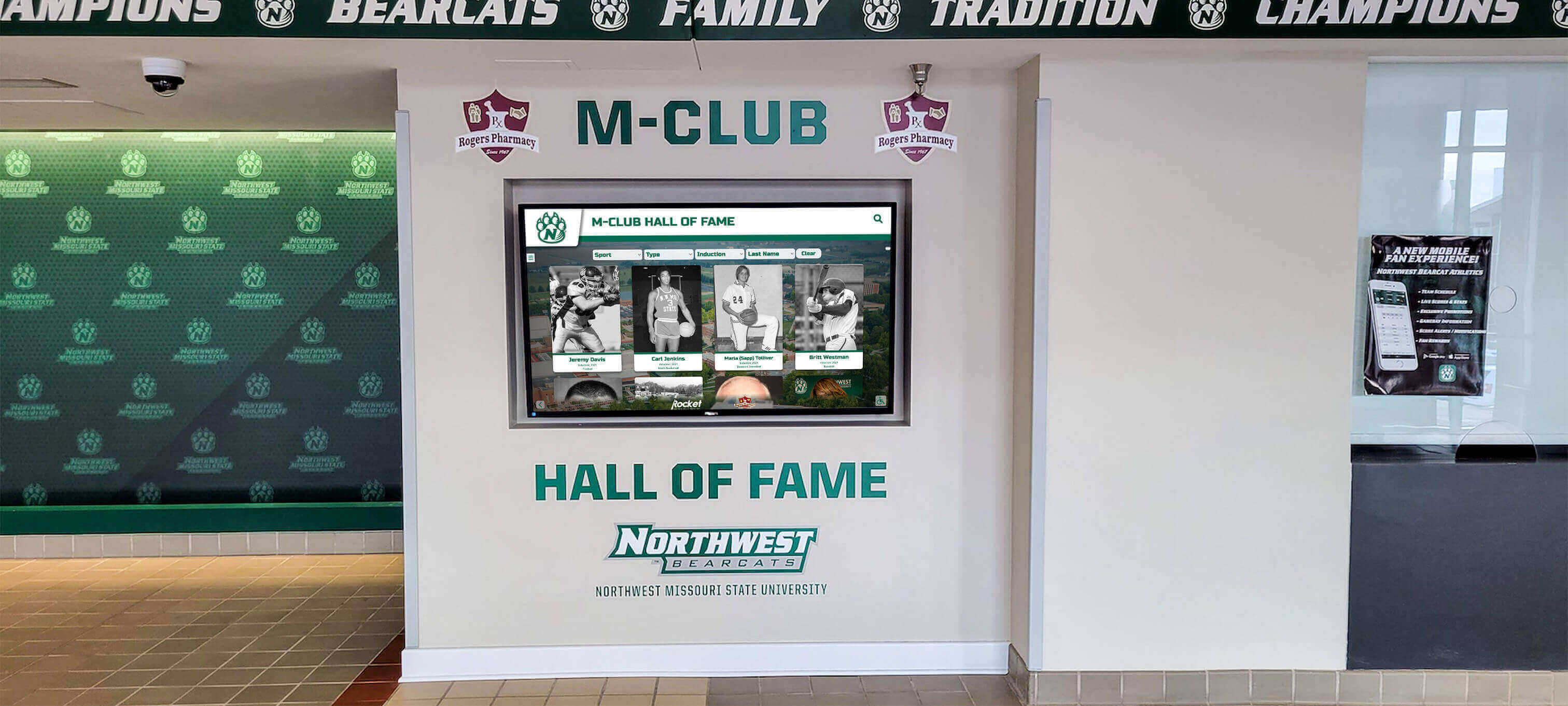
Subscription vs. One-Time Cost Analysis
Payment structure significantly affects long-term expenses and budget planning.
Annual Subscription Models:
- Pros: Lower upfront costs, continuous updates, predictable expenses, easier approval
- Cons: Ongoing budget commitment, total cost increases over time
- Typical Range: $2,000-$4,000 annually
- 5-Year Total: $10,000-$20,000
One-Time Purchase Models:
- Pros: No ongoing fees, lower long-term cost, budget certainty
- Cons: Higher initial investment, outdated software risk, upgrade costs
- Typical Range: $15,000-$25,000
- 5-Year Total: $15,000-$25,000 (plus potential upgrade costs)
Break-Even Analysis: Subscription models cost less for the first 3-4 years but exceed one-time costs after 5-7 years. Choose based on:
- Budget approval ease (subscriptions often easier)
- Fiscal planning preferences
- Expected system lifespan
- Upgrade priorities
- Software importance
Many athletic directors prefer subscriptions initially, gaining budget approval more easily with smaller annual costs, then reassessing after demonstrating value.
Leveraging Existing Infrastructure
Schools often already own assets usable for digital recognition, dramatically reducing project costs.
Existing Assets to Leverage:
- Unused large-screen TVs ($800-$2,000 value)
- Computer labs with available workstations
- Network infrastructure already in place
- Mounting brackets from previous displays
- Staff with technical installation capabilities
Repurposing Opportunities:
- Convert existing digital signage to recognition
- Repurpose classroom displays during summer
- Use athletic office screens after hours
- Share displays with academic recognition
One athletic director saved $6,000 by repurposing an underutilized conference room display, purchasing only software and a media player for $2,500 total—achieving full recognition capability at 70% cost reduction.
Comparing Top Solutions for Budget-Conscious ADs
Understanding the competitive landscape helps athletic directors select optimal solutions for their specific circumstances and constraints.
Rocket Alumni Solutions
Price Range: $3,000-$8,000 annually (software subscription) or complete systems from $12,000
Strengths:
- Purpose-built for athletic and alumni recognition
- Intuitive content management requiring minimal training
- Athletic-specific templates and workflows
- Excellent customer support and training
- Cloud-based with web accessibility
- Regular feature updates included
Best For: Schools wanting professional, purpose-built solutions with ongoing support and updates. Particularly strong for programs needing to update content frequently with minimal technical expertise.
Budget Advantages:
- Subscription model eases budget approval
- No custom development costs required
- Included support reduces hidden expenses
- Templates accelerate implementation
DIY Options (Google Slides, PowerPoint)
Price Range: Free (hardware costs only)
Strengths:
- Zero software costs
- Familiar interfaces requiring no training
- Complete control over design
- No vendor dependencies
Limitations:
- Significant staff time requirements
- Basic functionality and limited interactivity
- Manual updates consuming hours weekly
- No purpose-built athletic features
- Limited scalability for comprehensive recognition
- No analytics or performance tracking
Best For: Extremely limited budgets, temporary solutions, or schools with dedicated tech staff available for ongoing management.
Hidden Costs:
- 5-10 hours monthly for updates and maintenance
- Staff time value typically exceeds $100-$200 monthly
- Opportunity cost of time unavailable for other priorities
While “free” appears attractive, most athletic directors find that staff time costs exceed paid software subscriptions within 6-12 months.
Traditional One-Time Systems
Price Range: $15,000-$30,000
Strengths:
- Complete package including hardware and installation
- No ongoing subscription fees
- Ownership vs. licensing
Limitations:
- Higher upfront costs harder to approve
- Software often becomes outdated
- Limited to purchased feature set
- Updates may require additional costs
- Vendor viability concerns
Best For: Well-funded programs, situations where ongoing budget commitments pose challenges, or athletic directors who prefer ownership models.
Long-Term Considerations: After 5-7 years, technology often requires replacement regardless of initial cost. Subscription models that continuously update may provide better value over institutional timelines despite higher cumulative costs.
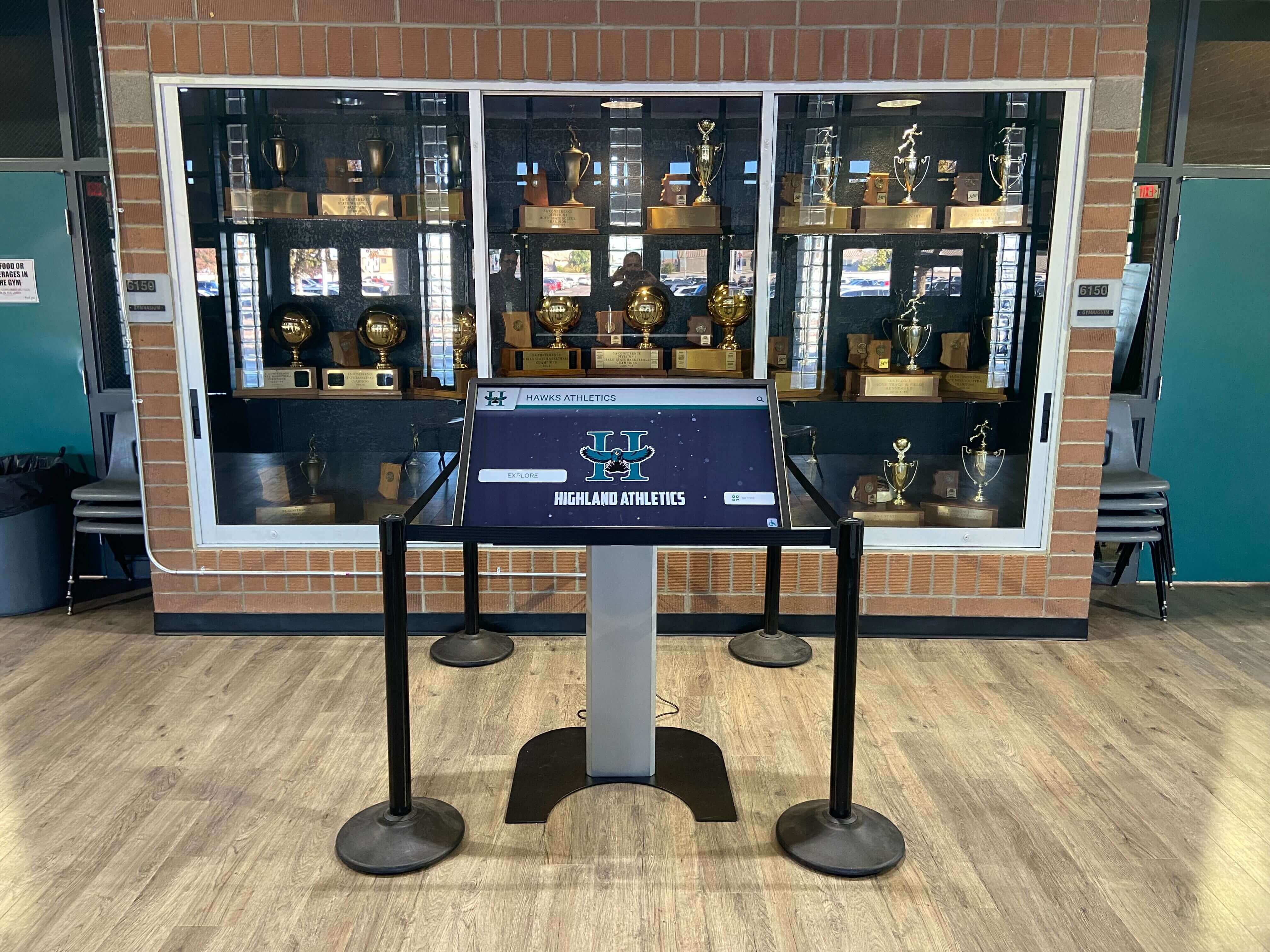
Budget Planning: A Step-by-Step Framework
Successful implementation requires systematic planning that addresses financial, operational, and strategic considerations.
Step 1: Define Recognition Objectives (Week 1)
Clear goals guide appropriate investment levels and solution selection.
Questions to Answer:
- Which sports and activities need recognition?
- How many athletes annually?
- Historical athlete inclusion priorities?
- Desired display locations?
- Update frequency expectations?
- Web accessibility requirements?
- Integration with existing systems?
Documentation: Create simple spreadsheet quantifying:
- Current athletes requiring recognition annually
- Historical athletes to include eventually
- Sports/activities by priority
- Desired features ranked by importance
Step 2: Calculate Total Cost of Ownership (Week 1-2)
Understanding complete costs prevents budget surprises.
Initial Investment:
- Hardware: $3,000-$15,000
- Software: $0-$5,000
- Installation: $0-$2,000
- Initial content development: $500-$2,000
- Training: $0-$500
Ongoing Costs:
- Software subscriptions: $2,000-$5,000 annually
- Content updates: $0-$1,000 annually (if outsourced)
- Maintenance: $200-$500 annually
- Electricity: $50-$100 annually
5-Year Total: Typically $15,000-$35,000 depending on solution scope
Compare against current recognition spending (trophies, plaques, engraving, display cases) to understand net investment after savings.
Step 3: Identify Funding Sources (Week 2-4)
Develop specific funding strategy matching your school context.
Funding Mix Example:
- Year-end school funds: 40% ($4,800)
- Booster club contribution: 30% ($3,600)
- Corporate sponsorships: 20% ($2,400)
- Alumni donations: 10% ($1,200)
- Total project: $12,000
Prioritize by:
- Approval likelihood
- Timeline constraints
- Relationship effort required
- Long-term sustainability
Most successful projects combine 2-4 funding sources rather than depending on single source, spreading risk while building broader stakeholder buy-in.
Step 4: Build Business Case (Week 3-4)
Professional proposals dramatically increase approval rates.
Essential Components:
- Executive summary (1 page)
- Problem statement (current recognition limitations)
- Proposed solution details
- Cost breakdown with alternatives compared
- Funding strategy
- Implementation timeline
- Expected benefits and outcomes
- Risk mitigation approach
Visual Elements:
- Mockups showing potential displays
- Comparison charts of solution options
- Photos of successful implementations elsewhere
- ROI projections and payback analysis
Include testimonials from other athletic directors who implemented similar systems, as peer validation significantly influences decision-makers.
Step 5: Secure Approvals (Week 5-8)
Navigate approval processes strategically for maximum success probability.
Key Stakeholders:
- Principal or head of school
- Finance or business office
- Booster club leadership
- Athletic director supervisor
- Technology department
- Facilities management
Presentation Strategy:
- Schedule individual meetings before formal requests
- Address concerns proactively
- Provide follow-up materials
- Be flexible on timing and phasing
- Celebrate small wins toward larger goal
Expect 6-12 week approval timelines for projects requiring multiple stakeholder agreement. Start early and maintain consistent communication throughout.
Step 6: Vendor Selection (Week 6-8)
Choose partners carefully as this relationship affects long-term satisfaction.
Evaluation Criteria:
- Customer references from similar schools
- Implementation support quality
- Training comprehensiveness
- Ongoing support responsiveness
- Financial stability and longevity
- Product roadmap and update frequency
- Contract terms and flexibility
Due Diligence:
- Contact at least 3 current customers
- Request live product demonstrations
- Review contracts with legal counsel
- Test customer support responsiveness
- Validate claimed capabilities
- Understand upgrade and cancellation policies
Cheapest option rarely proves best value. Focus on total cost of ownership including support quality, update frequency, and long-term vendor viability.
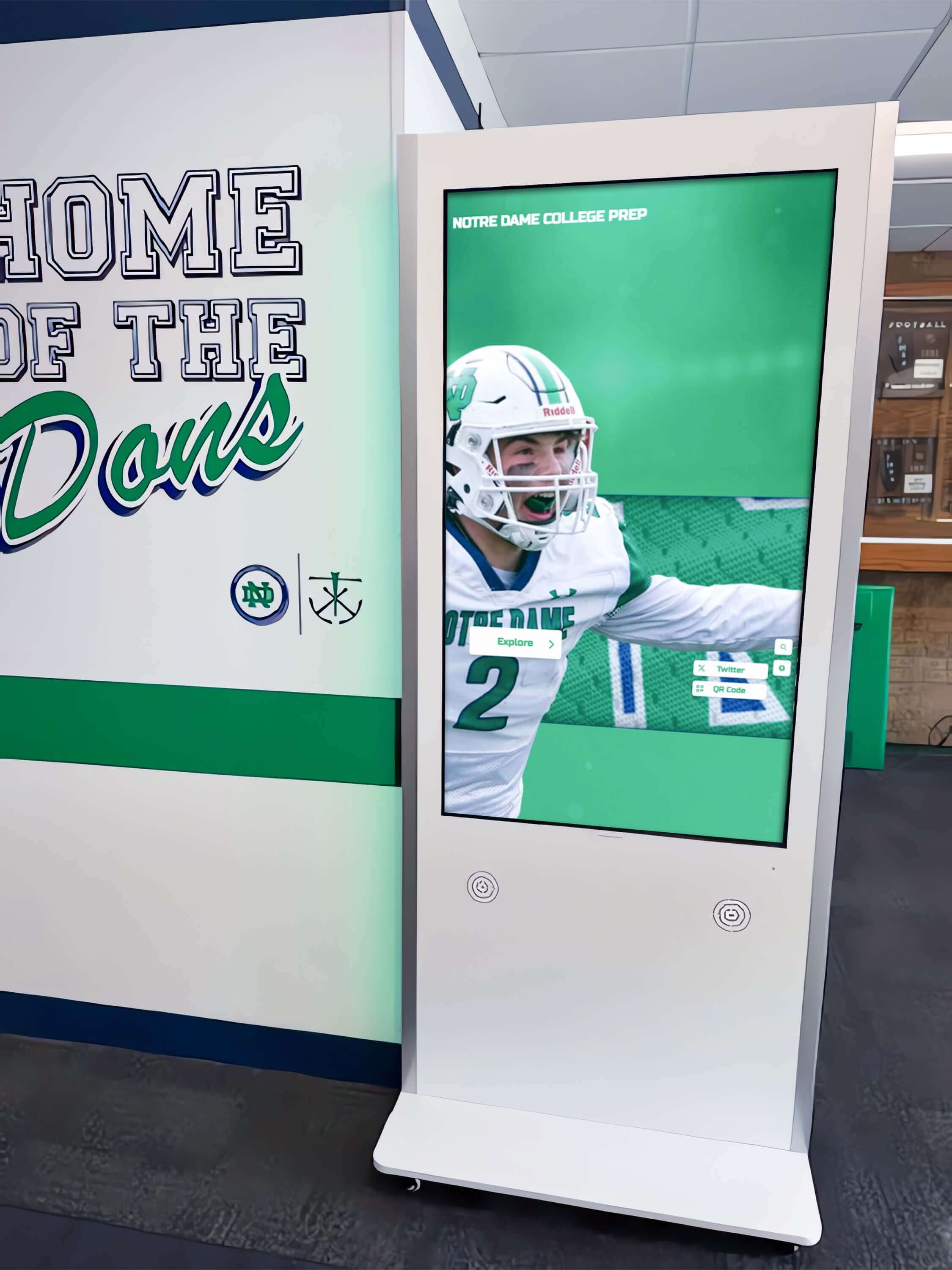
Common Pitfalls and How to Avoid Them
Learn from mistakes other athletic directors made to streamline your implementation.
Underestimating Content Development Time
The Problem: Many athletic directors focus on technology costs while underestimating time required for content creation—athlete photos, biographical information, statistics, historical research.
The Solution:
- Allocate 40-60 hours for initial content development
- Recruit volunteers (coaches, parents, students) to assist
- Use existing materials (yearbooks, programs, websites)
- Implement in phases rather than attempting completeness immediately
- Partner with journalism or computer classes for student involvement
Choosing Based Solely on Price
The Problem: Lowest-cost solutions often carry highest total ownership costs through poor support, limited features, or excessive staff time requirements.
The Solution:
- Calculate 5-year total cost of ownership, not just initial price
- Value staff time at realistic rates ($25-$50/hour)
- Consider replacement costs if cheap solutions fail
- Prioritize solutions with excellent support
- Accept that quality costs money but delivers value
Neglecting Network Requirements
The Problem: Digital recognition requires reliable network connectivity. Poor WiFi or inadequate bandwidth creates frustrating performance issues.
The Solution:
- Involve IT department early in planning
- Test network connectivity at proposed locations
- Budget for network improvements if needed ($500-$2,000)
- Consider hardwired Ethernet over WiFi when possible
- Ensure adequate bandwidth for video content
Failing to Plan for Updates
The Problem: Digital recognition requires ongoing content updates. Systems neglected for months lose effectiveness and become stale.
The Solution:
- Assign specific staff responsibility for updates
- Establish regular update schedules (weekly or monthly)
- Create simple workflows for adding new athletes
- Set expectations with coaches about content submission
- Schedule quarterly reviews for freshness
Skipping Training
The Problem: Staff uncomfortable with systems don’t use them effectively, undermining investment value.
The Solution:
- Require comprehensive training for all content managers
- Record training sessions for future reference
- Create simple written procedures and checklists
- Schedule follow-up training sessions as needed
- Choose platforms with excellent documentation and support
Long-Term Budget Sustainability
Initial funding represents only part of success. Long-term sustainability requires ongoing budget planning.
Year-One Costs
Typical Breakdown:
- Hardware: $8,000
- Software (first year): $3,000
- Installation: $1,500
- Initial content: $1,000
- Training: $500
- Total Year One: $14,000
Ongoing Annual Costs
Years 2-5:
- Software subscription: $3,000
- Content updates: $500 (if using volunteers)
- Maintenance: $300
- Annual Cost: $3,800
Budget Source Options:
- Athletic operating budget
- Booster club operational support
- Sponsor renewals
- Small alumni gifts
- Shared with academics (if multi-use)
Most athletic directors report that once initial investment is approved, ongoing costs integrate easily into standard operating budgets—especially when donor recognition and sponsorship visibility generate continued financial support.
Building Budget Resilience
Strategies for Long-Term Sustainability:
- Cultivate multiple funding sources vs. single dependency
- Renew sponsorships annually with multi-year commitments
- Build small reserve fund for unexpected costs
- Demonstrate value through regular usage reports
- Involve broader community in ownership and support
Successful programs view digital recognition as infrastructure investment similar to scoreboards or sound systems—essential program elements warranting reliable funding rather than optional expenses subject to annual debate.
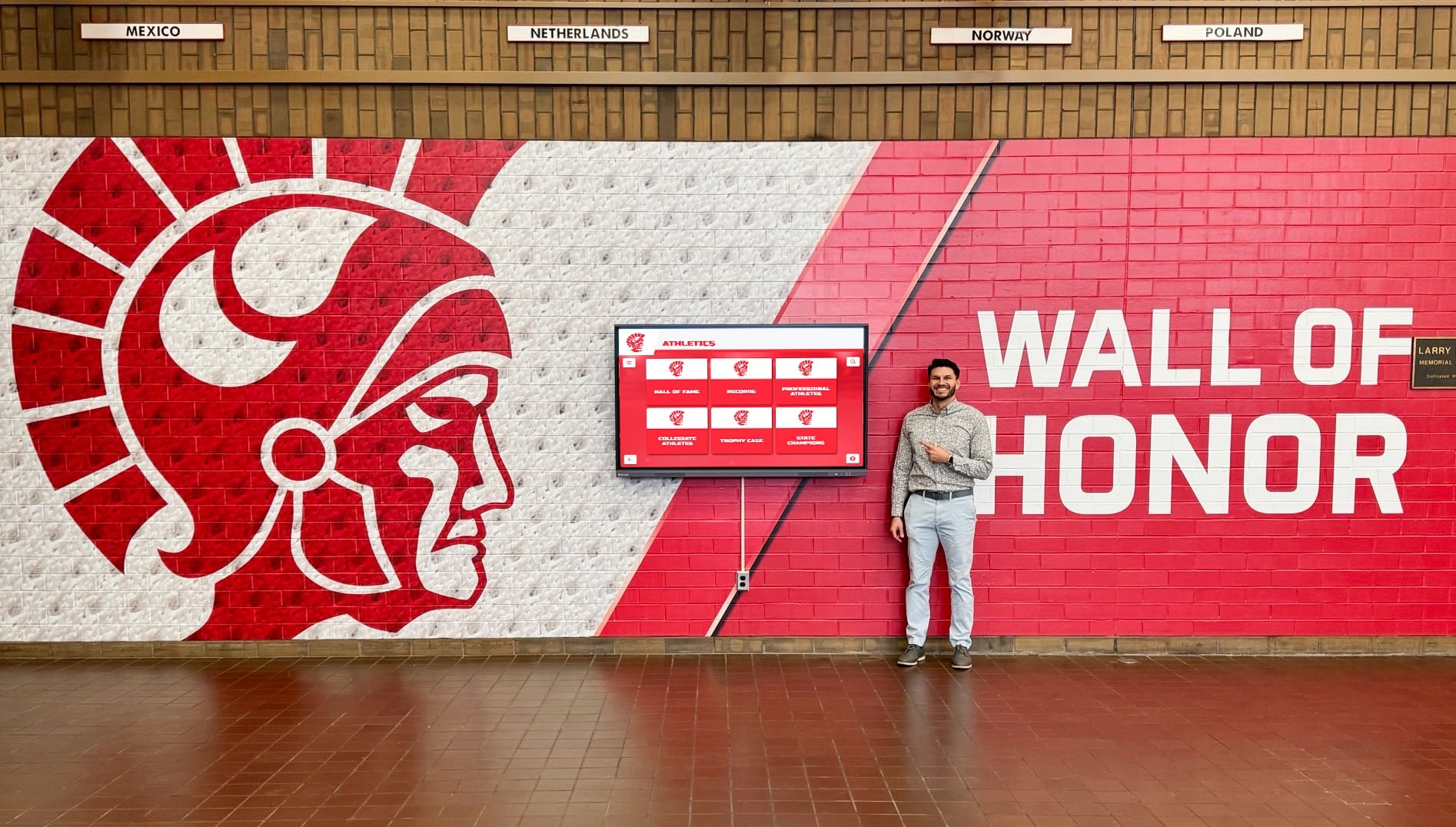
ROI: Measuring and Communicating Value
Demonstrating return on investment justifies initial spending while securing ongoing support.
Quantifiable Benefits
Direct Cost Savings:
- Trophy and plaque costs avoided: $2,000-$5,000 annually
- Engraving expenses eliminated: $500-$1,500 annually
- Display case purchases prevented: $2,000-$8,000 every 5-7 years
- Staff time saved on physical updates: 20-40 hours annually
- Storage space freed: 100-300 square feet
Revenue Impact:
- Increased booster membership from enhanced pride
- Higher athletic event attendance
- Improved sponsor retention through visibility
- Better recruiting leading to program success
- Enhanced fundraising through professional presentation
Intangible Benefits
Program Impact:
- Improved athlete morale and motivation
- Enhanced sense of program tradition and pride
- Stronger parent satisfaction with recognition
- Better coach retention through professional environment
- Increased media coverage of achievements
Community Building:
- More inclusive recognition across all sports
- Improved alumni connections through digitizing plaques and trophies
- Enhanced school reputation in community
- Stronger student athlete recruitment
- Improved facility appearance and professionalism
Tracking and Reporting
Key Metrics to Monitor:
- Cost savings vs. previous recognition methods
- Usage statistics (views, time spent, searches)
- Social media shares and digital reach
- Athlete and parent satisfaction scores
- Booster and sponsor feedback
- Recruiting impact mentions
Reporting Schedule:
- Quarterly usage summaries for administration
- Annual ROI analysis for budget justification
- Success stories highlighting specific impacts
- Photos and testimonials from stakeholders
- Comparison data showing growth over time
Regular reporting maintains visibility for your investment while building case for future enhancement or expansion.
Making the Decision: Your Next Steps
Armed with comprehensive information about costs, funding strategies, and implementation approaches, you’re ready to move forward with digital recognition for your athletic program.
Immediate Actions (This Week)
Assess your current situation
- Calculate annual spending on traditional recognition
- Identify space limitations and recognition gaps
- List potential funding sources specific to your school
- Determine timeline flexibility and urgency
Research specific solutions
- Request information from 3-5 potential vendors
- Schedule demonstrations of platforms
- Contact athletic directors at reference schools
- Review online examples and capabilities
Begin budget conversations
- Schedule meeting with principal or supervisor
- Discuss with booster club leadership
- Identify corporate sponsorship prospects
- Explore alumni network interest
Planning Phase (Weeks 2-4)
Develop detailed proposal
- Define specific recognition objectives
- Calculate total cost of ownership
- Create funding strategy combining sources
- Build business case with visuals
Secure stakeholder input
- Present to coaches for feedback
- Involve parent leaders in planning
- Consult IT on technical requirements
- Engage facilities on installation logistics
Finalize vendor selection
- Compare proposals and pricing
- Validate references thoroughly
- Negotiate terms and timeline
- Review contract carefully
Implementation Phase (Weeks 5-12)
Execute funding strategy
- Submit formal budget requests
- Solicit booster club approval
- Approach corporate sponsors
- Launch alumni fundraising campaign
Coordinate installation
- Schedule installation during optimal timing
- Prepare content in advance of launch
- Arrange training for content managers
- Plan unveiling or launch event
Launch and promote
- Announce new recognition capabilities
- Demonstrate to athletes and parents
- Share on social media platforms
- Celebrate improvement to program
Digital recognition transforms how schools honor student-athletes while creating sustainable solutions that grow more valuable over time. While initial budget constraints create legitimate concerns, the creative funding strategies and value maximization approaches outlined in this guide make digital recognition achievable for athletic directors at virtually every budget level.
The athletic directors who successfully implement these systems consistently report that the initial funding challenge proved far less difficult than anticipated when approached strategically with professional proposals, diverse funding sources, and clear demonstration of value. Your athletes deserve comprehensive recognition that celebrates their dedication and achievements—and your budget constraints shouldn’t prevent you from providing it.
Frequently Asked Questions
What’s the absolute minimum cost to implement digital recognition?
The most budget-friendly approach involves purchasing software subscription ($2,000-$3,000 annually) while repurposing an existing large-screen TV or monitor you already own. Adding a basic media player ($200-$500) creates functional digital recognition for approximately $2,500-$3,500 initial investment. While this minimalist approach lacks touchscreen interactivity and professional installation, it provides genuine digital recognition capability for extremely tight budgets.
Can we start with one display and add more later?
Yes, phased implementation represents one of the most popular approaches for budget-conscious athletic directors. Begin with a single display in your highest-traffic location (main athletic lobby or gym entrance), demonstrate value over 6-12 months, then use proven success to justify expanding to additional locations. Most digital recognition platforms accommodate multiple displays at discounted incremental costs, making expansion financially manageable.
How long does digital recognition typically last before needing replacement?
Commercial-grade displays generally last 5-7 years with regular use (16-18 hours daily). Many schools exceed this timeframe with proper maintenance. Software platforms continue indefinitely with subscription models that include updates. Most athletic directors planning 7-10 year system lifespans while budgeting for eventual hardware replacement hit realistic expectations. Quality initial hardware investment significantly affects longevity.
Do monthly payment plans exist for digital recognition systems?
While less common than annual subscriptions, some vendors offer monthly payment plans for complete systems. These typically spread costs across 12-36 months at slightly higher total cost than upfront payment but make budget approval easier for schools with constrained capital budgets. Equipment leasing through third-party financing companies provides another monthly payment option, though interest costs increase total investment.
What happens if we can’t afford ongoing subscription costs after the first year?
This legitimate concern makes vendor selection critical. Prioritize providers with strong track records, stable business models, and fair contract terms. Many vendors offer multi-year pricing discounts that lock in rates while spreading risk. Some allow payment pauses during financial difficulties. For complete ownership certainty, consider one-time purchase systems despite higher upfront costs. Building subscription costs into permanent operating budgets prevents this situation.
Can digital recognition really save money compared to traditional methods?
Yes, but savings timing varies. Initial investment exceeds single-year traditional spending, but digital recognition eliminates ongoing engraving, plaque, and display case costs that accumulate substantially over 5-10 years. Most athletic directors calculate break-even at 3-5 years depending on their specific traditional spending levels. Add intangible benefits like unlimited capacity, easier updates, and enhanced engagement, and value proposition strengthens significantly beyond pure cost comparison.
This content was produced by Rocket Alumni Solutions to provide athletic directors with actionable guidance for implementing digital recognition systems within budget constraints. Product names and trademarks mentioned belong to their respective owners.
